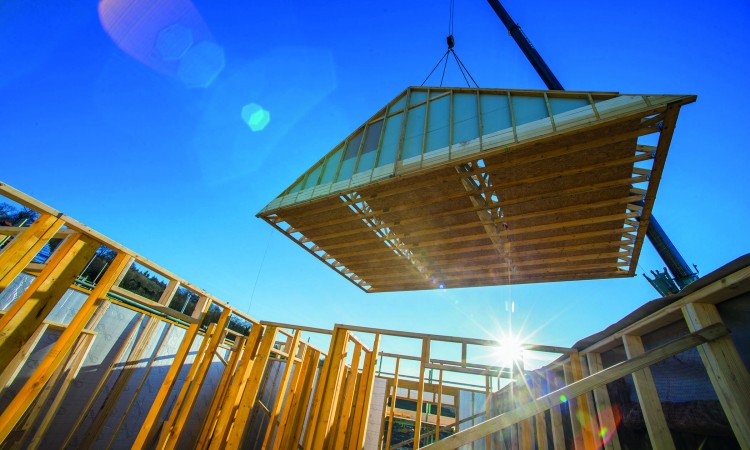STA invited to participate in the Timber in Construction Working Group
06/06/2022

The Structural Timber Association has been invited to participate in the Timber in Construction Working Group which brought together key industry stakeholders to develop a policy roadmap to help the Government safely increase the use of timber in construction, a crucial step in achieving the UK’s Net Zero target for 2050.
The Timber in Construction (TiC) working group is tasked with identifying significant actions that should be taken by the Government, the construction industry and the timber industry in order to increase the number of timber and hybrid structures built in the UK. To identify the key actions to take, a full understanding of the barriers faced in the construction industry is crucial. During a recent luncheon, the STA asked Mark Wakeford, Managing Director at Stepnell, what barriers he believes are preventing more widespread use of structural timber:
“Many of the contractors I represent struggle to use structural timber systems, as it costs them far more to insure than ‘traditional’ methods. There are, of course, some insurers that will back timber projects. If you can get the right information to the right people in the right insurance roles, we can expect a greater structural timber uptake. Bridging the knowledge gap between the timber and insurance sectors will be key.
“Aside from that, I think that solving the skills shortage will be crucial. Although the skills shortage is being felt across all materials, it is much easier to find a bricklayer than a CLT installer, for example. As such, this issue needs to be tackled sooner rather than later to see some success.”
The TiC working group has two primary objectives – to foster collaboration between sectors to develop a clear policy to increase timber in construction and to produce a policy roadmap to outline a clear implementation plan. Oliver Schofield, Co-Founder of Lignum Risk Partners, offered an interesting solution to increasing the use of structural timber in the UK and improving the accountability for material usage:
“We need to have a standardised system in place that provides insurers with access to much more robust data. Don’t be mistaken, many insurers would like to support timber projects but without the data or knowledge, it is difficult for them to do so.
“I think that the most effective solution would be to introduce a blockchain that can be used as a record. Everybody should be obliged by regulation to record their use of materials, whether sustainable or not. This will not only ensure that no corners are being cut, but it will also equip insurers with a wealth of data that is desperately needed.”
Many figures within the timber construction industry believe that boosting market confidence with lenders, insurance companies and warranty providers is the best route forward for a wider uptake in timber construction. Mike Ormesher, Director of the Offsite Homes Alliance, feels that more must be done to aid the education and understanding of timber and hybrid construction to alleviate any safety concerns:
“There must be an open channel of communication to help insurers and investors understand timber construction and allow facts to dispel the misconceptions of structural timber. Perhaps the use of workshops, seminars, webinars and physical roadshow demonstrations is the best route forward to improve this knowledge base of using structural timber in construction.”
Suzannah Nichol Chief Executive of Build UK voiced concerns over whether the construction sector is approaching challenges with those outside the industry in the correct manner:
“Within the construction sector, we spend a lot of time discussing issues that are not directly within our control, instead of addressing those we can influence head on. I believe that the issues with insurers and financers are exacerbated by the poor level of communication between the industries. To deal with this, we need to be speaking in a language that those outside the industry understand. Instead of shouting loudly about all the problems in construction, we should be speaking in simpler terms about what ‘good’ looks like in the industry in terms of build quality, materials, and competence, explaining what we are doing about each of these and what we need others to do.
To this day, certain terminology used within cross-industry discussions and documents confuse even those within construction, which will only add layer upon layer of confusion to those outside of it. We need to be clear about standards and competence, while communicating in layman’s terms to improve clarity across the board.”
While the policy roadmap produced by the Timber in Construction working group will not be Government policy, it will be submitted to ministers for approval. The Climate Change Committee (CCC) advises that increased use of timber in construction is required to achieve net-zero, suggesting that timber-frame new build houses need to increase from 28% to 40% by 2050 to achieve these carbon-neutral goals. This may sound like we have a great deal of time, but in reality, these changes must be implemented immediately to allow ample time for the environmental effect to be felt.
The STA works closely with industry stakeholders to address all the issues that timber construction faces in the industry, including those regarding insurance. The association continues to commission and compile a significant amount of research resulting in guides and whitepapers that provide a better understanding of the use of timber in construction from a risk management perspective. This research gives factual scientific data and statistical evidence to present to the insurance sector. The STA will continue to raise the profile of timber as a safe construction material, backed by scientific data and will support the TiC with this evidence along with its in-depth knowledge of the structural timber industry.